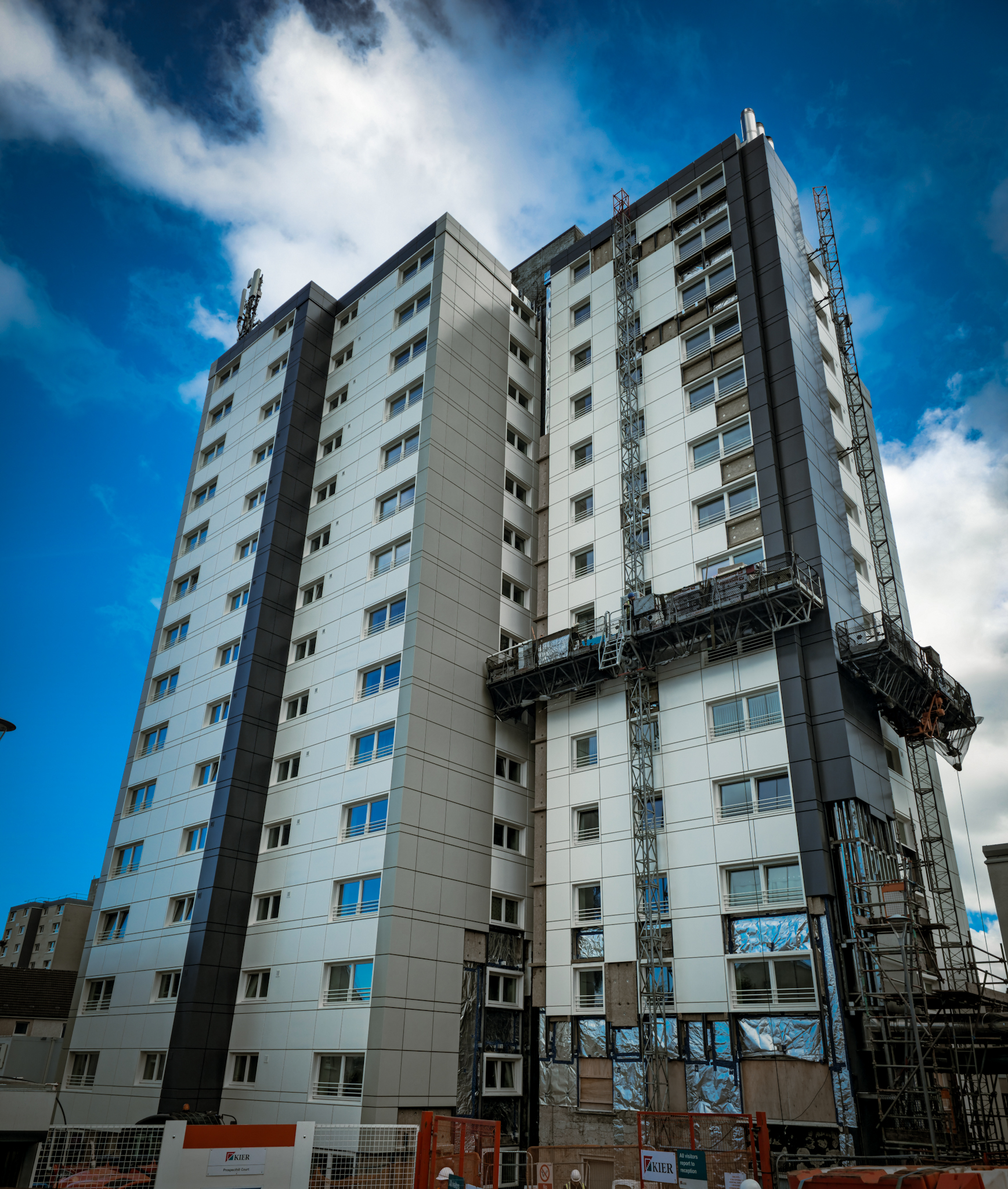Duncan Smith: A low carbon approach to multi-storey retrofitting

As the Prospecthill Court Retrofit Project comes to an end, River Clyde Homes’ head of energy & sustainability Duncan Smith shares the challenges and benefits of bringing multi-storey blocks up to a modern standard.
Achieving net zero presents housing associations and local authorities with a complex challenge. As a landlord, River Clyde Homes is committed to reducing carbon emissions and transitioning our homes away from fossil fuel heating systems, such as gas boilers, to renewable heating, such as heat networks and heat pumps. However, we know we’ve got to do this without disadvantaging our customers, as this is key to ensuring a “just transition” for our tenants while meeting our net zero commitments.
Whilst new build developments are often the focus for many councils and associations, over 80% of the homes in use in 2050 have already been built. Together with the growing awareness of carbon emissions from the materials we use in construction (embodied carbon), our focus at River Clyde Homes is on our existing homes and how we retrofit them to address fuel poverty for our customers and reduce operational carbon at the same time.
One of the projects we’re happy to share is our Prospecthill Court Retrofit Project, which will be completed later this month. This multi-storey block, built in the early 1970s in the Broomhill area of Greenock, is home to ninety-one households in a mix of one—and two-bedroom flats.
The homes are served by an existing low-carbon district heating network that provides heat and hot water to residents at a cheaper cost than the alternative - electricity. The area ranks as one of the most deprived areas of Scotland, being within the lowest 5% of the Scottish Index of Multiple Deprivation.

So, the cost-of-living crisis has disproportionately impacted our customers, many of whom are on low incomes. As a result, through public consultation, we committed to the residents in 2022 to prioritise the block for investment and insulate it with a solution that would show our commitment to tackling net zero and mitigating fuel poverty.
Our Approach
We identified four critical areas for delivering a successful project at Prospecthill, that can equally be used across our homes – these were:
- Alleviating fuel poverty
- Reducing carbon emissions
- Engaging with our customers
- Ensuring value for money
At River Clyde Homes, one of our fundamental principles is ensuring a design-led approach to retrofit, and this project was no different. This approach separates the roles of our contractor from those of the designer, leading to a better overall approach to delivering more complex retrofit works when we’re onsite. It also ensures that we close the performance gap between design and delivery, leading to much better outcomes for our customers.
Based on these principles, back in 2022, we procured a multi-disciplinary design team that included BDP Architects, Currie & Brown and Thomson Bethune. The team’s remit was to develop a retrofit solution to address the energy demand within the block and reduce carbon emissions towards the AECB CarbonLite Retrofit Standard, a rigorous voluntary retrofit standard based on Passivhaus principles of high-quality insulation, improved air tightness and mechanical ventilation.
The solution we developed included an external rain-screen cladding system that incorporated insulation and triple-glazed windows to improve thermal efficiency and the look of the building, which residents told us was really important. The solution included air tightness measures and mechanical ventilation, which are critical in reducing energy demand and ensuring healthy homes.
We appointed Kier Construction to deliver the works in July 2023 through the SCAPE Scotland Framework, and the work will be completed over the next couple of weeks. Fairhurst acted as structural engineer. We received a £1.65 million grant from the Scottish Government Social Housing Net Zero Fund towards the overall costs, which was a big help.

To directly address fuel poverty, the retrofit works at Prospecthill have been designed to reduce the previous energy demand from around 16,750 kWh a year per flat to around 2,680 kWh – a reduction of over 80% in space heating. This will significantly improve the lives of the residents – both from a financial perspective and their health and well-being and contribute to the overall sustainability of the area.
But we’ll not stop when the scaffold comes down. Within the construction and retrofit world, post-occupancy evaluation is often overlooked, and we feel that’s to the detriment of how we can learn from this type of project. A colleague once said, “If you can’t measure it, you can’t improve it.” So, to quantify our work, we already have smart meters in each home that monitor the energy used for heating and hot water - allowing us to view energy consumption remotely.
We’ll also install IoT environmental sensors in several homes, which, together with the energy meters, will allow us to evaluate the project over the next two years and gain real insight into how tenants interact with the heating system and how we can best support them.
Lastly, the Prospecthill Court Retrofit Project will minimise the amount of carbon that goes into the atmosphere, both from an embodied and operational perspective. We’ve made several decisions on the insulation, glazing, and brickwork that we’ve used within the project to minimise embodied carbon. Operationally, we expect to save around 228 tonnes of CO2 over the next ten years through our use of an existing heat network for these homes.
Whilst this is a modest saving, it demonstrates how a social landlord like River Clyde Homes can play our part in addressing the climate emergency and mitigate fuel poverty for our customers —something we all need to do.















